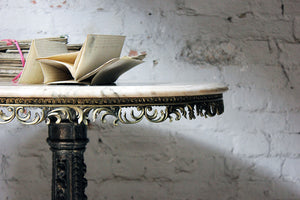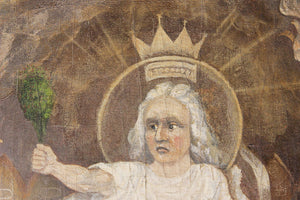SOLD
Origin: French
Period: Louis XVI
Provenance: Unknown
Date: c.1760-80
Width: 64.5”
Height: 52.25”
Depth: 1.5” (all in frame)
Using two yarns, one of wool and one of silk plied as one weft, depicting an ornate flower-filled two-handled vase flanked by garlands tied by blue ribbons, the flowers of blue, pink and white with green foliage on an oatmeal coloured ground and housed within a later 19thC giltwood frame, the whole at over five feet wide, surviving from the third quarter of eighteenth century France, and possibly Aubusson.
Condition wise the tapestry is a little tired and faded but still wonderfully beautiful as an entirety. The colours to the weave have faded overall, but still retain vibrant reds and blues. There is minor wear and losses to the silks with repairs to the gapping to the ground. The giltwood nineteenth century frame is pretty though it does have numerous losses and is decorative as such. The silk weft yarns are relatively fragile and in tightly woven figurative areas they have been partly abraded. It could benefit from being glazed.
This tapestry was designed to hang over a door in a formal interior and can be admired purely for the complicated technique and time-consuming method of tapestry weaving and carpet knotting. In the 18th century a single weaver could produce only one to six square meters per year, depending on the intricacy of the pattern. The looms required the weavers work the composition from its reverse and, frequently, from a pendicular orientation.
This is a particularly attractive example as it is not too busy and the motifs are allowed to breathe, the space giving the tapestry a better sense of scale and proportion.
Splendiferous.
Period: Louis XVI
Provenance: Unknown
Date: c.1760-80
Width: 64.5”
Height: 52.25”
Depth: 1.5” (all in frame)
Using two yarns, one of wool and one of silk plied as one weft, depicting an ornate flower-filled two-handled vase flanked by garlands tied by blue ribbons, the flowers of blue, pink and white with green foliage on an oatmeal coloured ground and housed within a later 19thC giltwood frame, the whole at over five feet wide, surviving from the third quarter of eighteenth century France, and possibly Aubusson.
Condition wise the tapestry is a little tired and faded but still wonderfully beautiful as an entirety. The colours to the weave have faded overall, but still retain vibrant reds and blues. There is minor wear and losses to the silks with repairs to the gapping to the ground. The giltwood nineteenth century frame is pretty though it does have numerous losses and is decorative as such. The silk weft yarns are relatively fragile and in tightly woven figurative areas they have been partly abraded. It could benefit from being glazed.
This tapestry was designed to hang over a door in a formal interior and can be admired purely for the complicated technique and time-consuming method of tapestry weaving and carpet knotting. In the 18th century a single weaver could produce only one to six square meters per year, depending on the intricacy of the pattern. The looms required the weavers work the composition from its reverse and, frequently, from a pendicular orientation.
This is a particularly attractive example as it is not too busy and the motifs are allowed to breathe, the space giving the tapestry a better sense of scale and proportion.
Splendiferous.



















